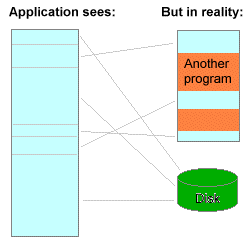Virtual memory facts for kids
Virtual memory is a clever way computers manage their computer memory. Think of it like this: your computer has a certain amount of RAM (fast, temporary memory) and a hard drive (slower, permanent storage). Virtual memory makes it seem like your computer has much more RAM than it actually does. This helps your computer run many programs at the same time, which is called multiprocessing.
When you open lots of apps or play a big game, they all need memory to work. Your computer doesn't get more processors or RAM just because you're running more programs. Instead, virtual memory helps share the memory that's already there.
How Virtual Memory Works
Virtual memory tricks each program into thinking it has its own huge, continuous block of memory. This "virtual" block isn't real in one place. Instead, parts of it might be in your computer's fast RAM, while other parts are stored on your slower hard drive.
A special part of your computer's CPU and the operating system work together to manage this. They translate the "virtual" memory addresses that programs use into the actual physical locations in RAM or on the hard drive.
Swapping and Paging
When a program needs a piece of memory that isn't currently in the fast RAM, the computer quickly moves that part from the hard drive into RAM. To make space, it might move other unused parts of memory from RAM back to the hard drive. This process is often called paging or swapping. It's like moving books on and off a small desk (RAM) to a big bookshelf (hard drive) as you need them.
Why Some Systems Don't Use It
Not all computer systems use virtual memory. For example, embedded systems (like those in a washing machine or a car's engine) usually don't. These systems need to respond very quickly and predictably.
With virtual memory, it's hard to know exactly how long it will take for a program to access memory. If the memory it needs is on the hard drive, it will take longer to load than if it's already in RAM. Because of this unpredictable timing, virtual memory isn't used in systems where a consistent, fast response is super important.
See also
 In Spanish: Memoria virtual para niños
In Spanish: Memoria virtual para niños


